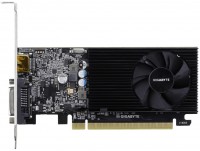Graphics Cards Gigabyte series Turbo (turbine)
prices on 1 modelGigabyte Turbo Series
In the last two years, NVIDIA has most often presented its reference graphics cards with the so-called centrifugal fan (or turbine) as the main cooling system, which most manufacturers subsequently send to the landfill, replacing them with classic air cooling systems. As a result, of the major brands, only Asus and Gigabyte do not forget about turbines, in the assortment of which there are separate lines of such video accelerators.
 |
The advantage of such systems over conventional fans lies in the reduced dimensions and nuances of cooling. Firstly, a turbine usually takes up fewer slots than an identical model with axial fans, so it is easier to place an SLI/Crossfire bundle of several cards with turbines inside the case. Secondly, the turbine does not emit hot air inside the housing towards the processor or the north bridge, which simplifies air circulation inside the housing. Therefore, in a system with a turbine graphics card, a conditional 12-core Ryzen 9 or Core i9 may well do with a box cooler.
The flip side of the coin is acceleration and noise level. For example, the Gigabyte GeForce RTX 2080 TURBO that visited our tests at one time left a dual impression: in automatic mode, it kept the temperature well within operating limits, but the dynamic core frequency dropped below the claimed level. Because of this, it was necessary to manually increase the speed of the turntable, and it made a lot of noise. The new 3080 in the Turbo version is not much different. If the RTX 3080 cards performed by Aorus or Windforce are practically not heard during rendering, the RTX 3080 Turbo will declare itself in full voice. Because of these features, Turbo graphics cards are more suitable for complex creative or computational work, rather than for games.









